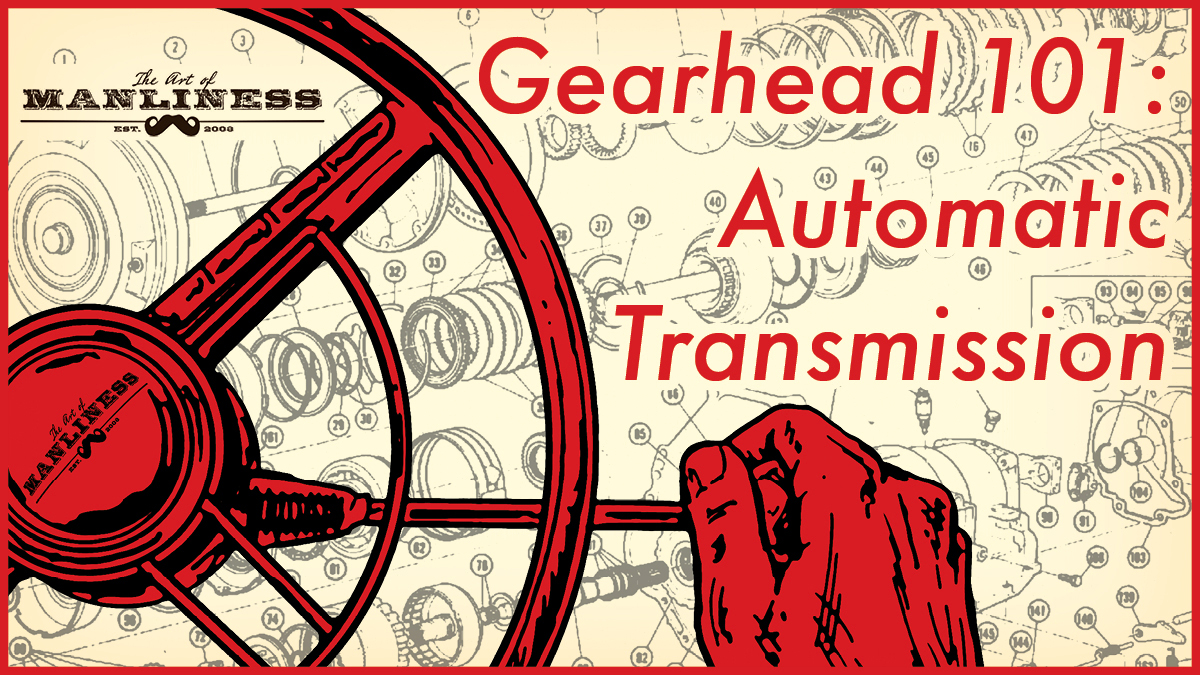
Welcome back to Gearhead 101 — a series on the basics of how cars work for the automotive neophytes out there.
If you’ve been following Gearhead 101, you know how a car engine works, how the engine transfers the power it generates via the drivetrain, and how a manual transmission functions as sort of a power switchboard between the engine and the drivetrain.
But most people these days (at least if you live in the United States) drive cars with automatic transmissions. Have you ever wondered how your car can shift into the appropriate gear without you having to do anything except for press on the gas pedal or brake?
Well, hold on to your butts. We’re about to walk you through one of the most amazing pieces of mechanical (and fluid) engineering in human history: the automatic transmission.
(Seriously, I’m not exaggerating: once you understand how automatic transmissions work, you’ll be awed that people were able to come up with this thing without computers.)
Review Time: The Purpose of a Transmission
Before we get into the ins and outs of how an automatic transmission works, let’s do a quick review of why vehicles need a transmission — of any kind — in the first place.
As discussed in our primer on how a car engine works, the engine of your vehicle creates rotational power. To move the car, we need to transfer that rotational power to the wheels. That’s what the car’s drivetrain — which the transmission is a part of — does.
But here’s the problem: an engine can only spin within a certain speed in order to operate efficiently. If it spins too low, you wouldn’t be able to get the car moving from a standstill; if it spins too fast, the engine can self-destruct.
What we need is some way to multiply the power produced by the engine when it’s needed (starting from a standstill, going up a hill, etc.), but also decrease the amount of power sent from the engine when it isn’t needed (going downhill, going really fast, slamming on the brakes).
Enter the transmission.
The transmission ensures that your engine spins at an optimal rate (neither too slow nor too fast) while simultaneously providing your wheels with the right amount of power they need to move and stop the car, no matter the situation you find yourself in. It sits between the engine and the rest of the drivetrain and sort of acts like a power switchboard for the car.
We previously went into detail on how manual transmissions accomplish this through gear ratios. By connecting different sized gears with one another, you can increase the amount of power that is delivered to the rest of the car without changing the speed of the engine’s rotational power all that much. If you don’t yet grasp the idea of gear ratios, I recommend you watch the video we included last time before you move on; nothing else will make sense unless you understand this concept.
With a manual transmission, you control which gears are engaged by pressing the clutch and shifting the gears into place.
On an automatic transmission, brilliant engineering determines which gear is engaged without you having to do a dang thing except to press the gas or the brake pedals. It’s automotive magic.
Parts of an Automatic Transmission
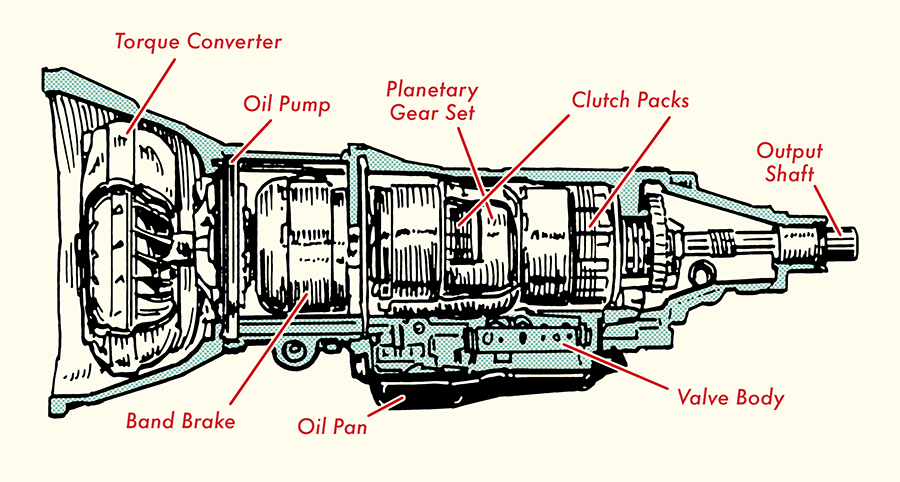
So by now, you should have a basic understanding of a transmission’s purpose: it ensures that your engine spins at an optimal rate (neither too slow nor too fast), while simultaneously providing your wheels with the right amount of power to move and stop the car, no matter the situation.
Let’s take a look at the parts that allow this to happen in the case of the automatic transmission:
Transmission Casing
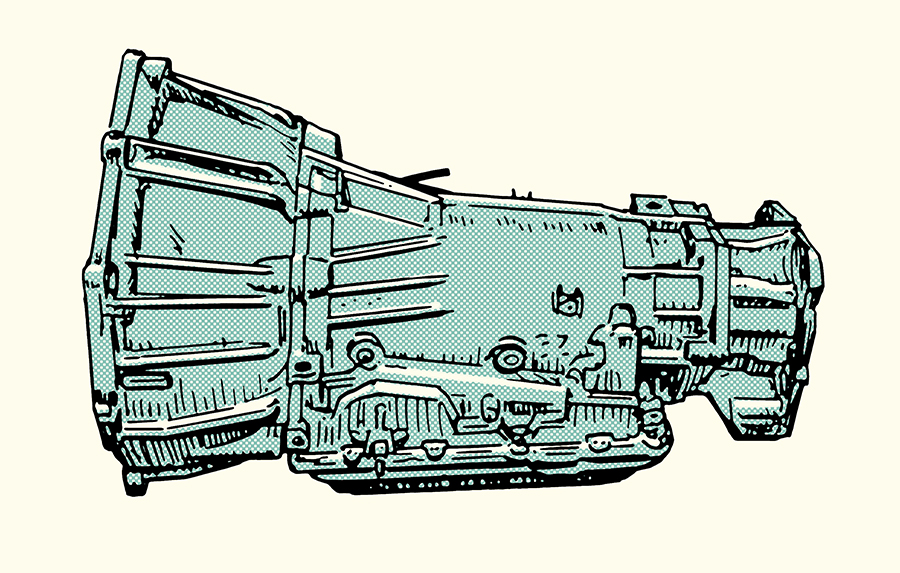
A transmission casing houses all the parts of the transmission. It sort of looks like a bell, so you’ll often hear it referred to as a “bell casing.†The transmission casing is typically made of aluminum. Besides protecting all the moving gears of the transmission, the bell casing on modern cars has various sensors that track input rotational speed from the engine and output rotational speed to the rest of the car.
Torque Converter
Ever wonder why you can turn on your car’s engine, but not have the thing move forward? Well, that’s because power flow from the engine to the transmission is disconnected. This disconnection allows the engine to continue running even though the rest of the car’s drivetrain isn’t getting any power. On a manual transmission, you disconnect power from the engine to the drivetrain by pressing in the clutch.
But how do you disconnect power from the engine to the rest of the drivetrain on an automatic transmission that doesn’t have a clutch?
With a torque converter, of course.
This is where the black magic of automatic transmissions begins (we haven’t even gotten to planetary gears yet).
The torque converter sits between the engine and the transmission. It’s a donut looking thing that sits inside the big opening of the transmission’s bell case. It has two primary functions in terms of transmitting torque:
- Transfers power from the engine to the transmission input shaft
- Multiplies engine torque output
It performs these two functions thanks to hydraulic power provided by the transmission fluid inside your transmission.
To understand how this works, we need to know how the different parts of a torque converter work.
Parts of a Torque Converter
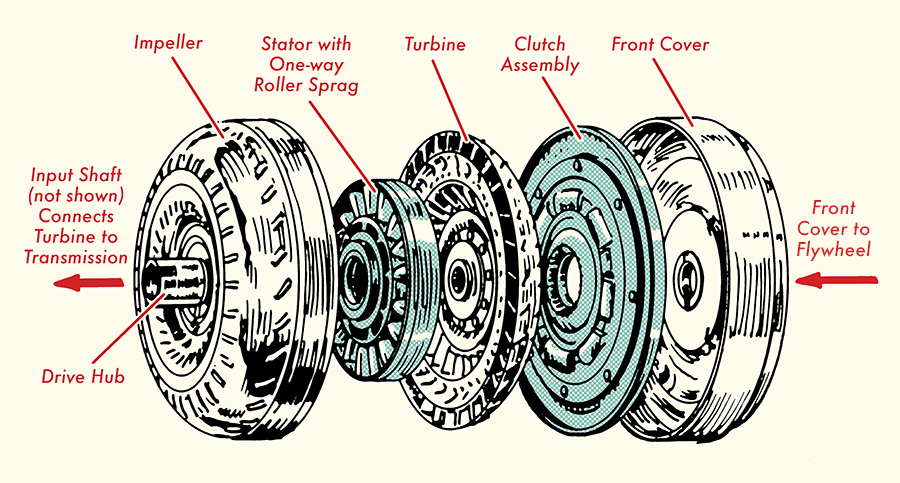
There are four main parts of a torque converter in most modern vehicles: 1) the pump, 2) the stator, 3) the turbine, and 4) the torque converter clutch.
1. Pump (aka impeller). The pump looks like a fan. It has a bunch of blades radiating from its center. The pump is mounted directly to the torque converter housing which in turn is bolted directly to the engine’s flywheel. Consequently, the pump spins at the same speed as the engine’s crankshaft. (You’ll need to remember that when we walk through how the torque converter works.) The pump “pumps†transmission fluid outwards from the center towards the . . .
2. Turbine. The turbine sits inside the converter housing. Like the pump, it looks like a fan. The turbine connects directly to the input shaft of the transmission. It’s not connected to the pump so it can move at a different speed than the pump. This is an important point. This is what allows the engine to turn at a different speed than the rest of the drivetrain.
The turbine can spin thanks to the transmission fluid that gets sent from the pump. The turbine’s blades are designed in a way so that the fluid it receives is moved towards the center of the turbine and back towards the pump.
3. Stator (aka Reactor). The stator sits between the pump and turbine. It looks like a fan blade or airplane propeller (do you see a pattern here?). The stator does two things: 1) sends transmission fluid from the turbine back to the pump more efficiently, and 2) multiplies torque coming from the engine to help get the car moving, but then sends less torque once the car is going at a good clip.
It accomplishes this thanks to some clever engineering. First, the blades on the reactor are designed in a way so that when the transmission fluid leaving the turbine hits the stator’s blades, the fluid is diverted in the same direction as the pump’s rotation.
Second, the stator is connected to a fixed shaft on the transmission via a one-way clutch. This means that the stator can only move in one direction. This ensures that fluid from the turbine is directed in one direction. The stator will only start spinning when the fluid speed from the turbine reaches a certain level.
These two design elements of the stator make the work of the pump easier and generate more fluid pressure. This, in turn, creates an amplified torque at the turbine and because the turbine is connected to the transmission, more torque can be sent to the transmission and the rest of the car. Whew.
4. Torque converter clutch. Thanks to how fluid dynamics work, power is lost as the transmission fluid goes from the pump to the turbine. This results in the turbine spinning at a slightly slower speed than the pump. This isn’t a problem when the car is getting going (in fact that speed difference is what allows the turbine to deliver more torque to the transmission), but once it’s cruising, that difference results in some energy inefficiencies.
To negate that energy loss, most modern torque convertors have a torque convertor clutch that’s connected to the turbine. When the car reaches a certain speed (usually 45-50 mph), the torque converter clutch engages and causes the turbine to spin at the same speed as the pump. A computer controls when the converter clutch is engaged.
So those are the parts of the torque converter.
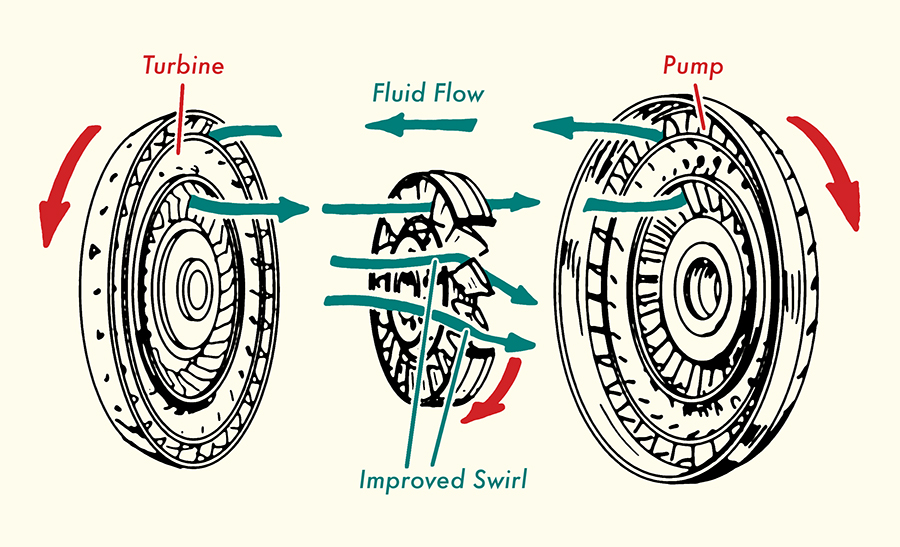
Let’s bring it all together and take a look at what the action of the torque converter would look like as you go from a dead stop to a cruising speed:
You turn on the car, and it’s idling. The pump is spinning at the same speed as the engine and is sending transmission fluid towards the turbine, but because the engine isn’t spinning very fast at a dead stop, the turbine doesn’t spin that fast, so it can’t deliver torque to the transmission.
You step on the gas. This causes the engine to spin faster, which causes the torque converter pump to spin faster. Because the pump is spinning faster, transmission fluid is moving fast enough from the pump to start spinning the turbine faster. The turbine blades send the fluid to the stator. The stator isn’t spinning yet because transmission fluid speed isn’t high enough.
But because of the design of the stator’s blades, as the fluid passes through them, it diverts the fluid back to the pump in the same direction as the pump is spinning. This allows the pump to move the fluid back to the turbine at a higher speed and creates more fluid pressure. When the fluid heads back to the turbine, it does so with more torque, causing the turbine to deliver more torque to the transmission. The car starts moving forward.
Over and over this cycle continues as your car speeds up. When you reach cruising speed, the transmission fluid reaches a pressure that causes the reactor blades to finally spin. With the reactor spinning, torque is reduced. At this point, you don’t need much torque to move the car because the car is moving at a good clip. The torque converter clutch engages and causes the turbine to spin at the same speed as the pump and the engine.
Alright, so the torque converter is what allows or prevents power from the engine to be transmitted to the transmission and what multiples torque to the transmission to get the car going from a dead stop. Time to take a look at the parts of the transmission that allow the car to shift automatically.
Planetary Gears
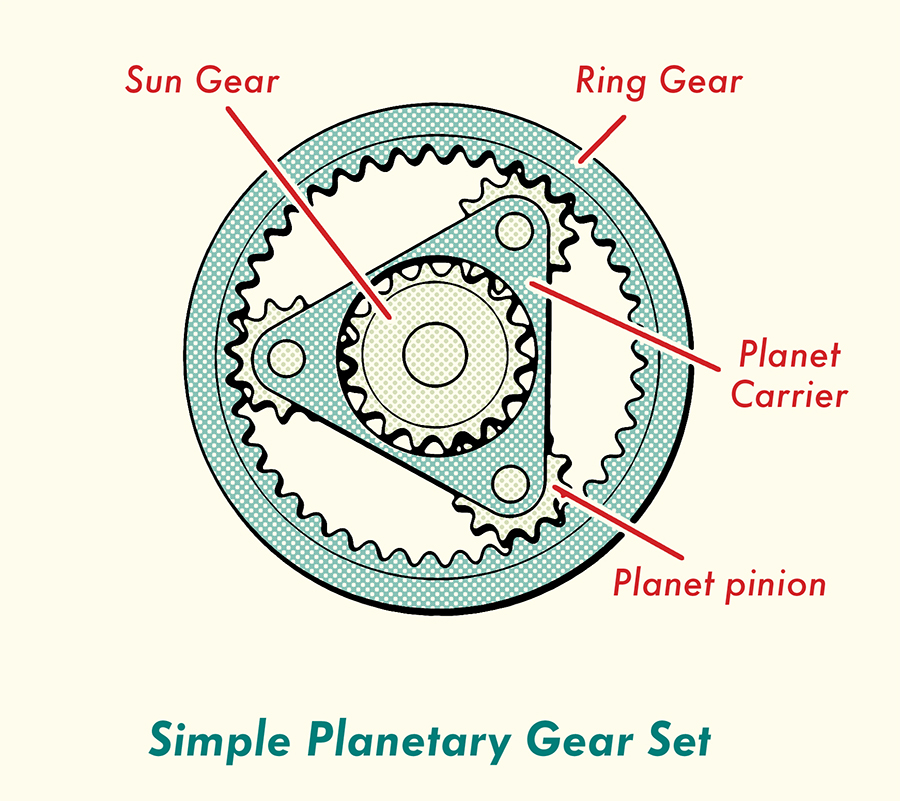
As your vehicle reaches higher speeds, it needs less torque to keep the car going. Transmissions can increase or decrease the amount of torque sent to the car’s wheels thanks to gear ratios. The lower a gear ratio is, the more torque is delivered. The higher a gear ratio is, the less torque is delivered.
On a manual transmission, you have to move your gear shift to change the gear ratios.
On an automatic transmission, gear ratios increase and decrease automatically. And this is able to happen thanks to the ingenious design of a planetary gear.
A planetary gear consists of three components:
- A sun gear. Sits at the center of the planetary gear set.
- The planet gears/pinions and their carrier. Three or four smaller gears that surround the sun gear and are in constant mesh with the sun gear. The planet gears (or pinions) are mounted and supported by the carrier. Each one of the planet gears spins on their own separate shafts that are connected to the carrier. Planet gears not only spin, but they also orbit the sun gear.
- The ring gear. The ring gear is the outer gear and has internal teeth. The ring gear surrounds the rest of the gear set, and its teeth are in constant mesh with the planet gears.
A single planetary gear set can achieve reverse drive and five levels of forward drive. It all depends on which of the three components of the gear set is moving or held stationary.
Let’s take a look at that in action with the different components acting as either the input gear (the gear that is generating the power), the output gear (the gear that receives power), or being held stationary.
Sun Gear: input gear / Planetary Carrier: output gear / Ring Gear: held stationary
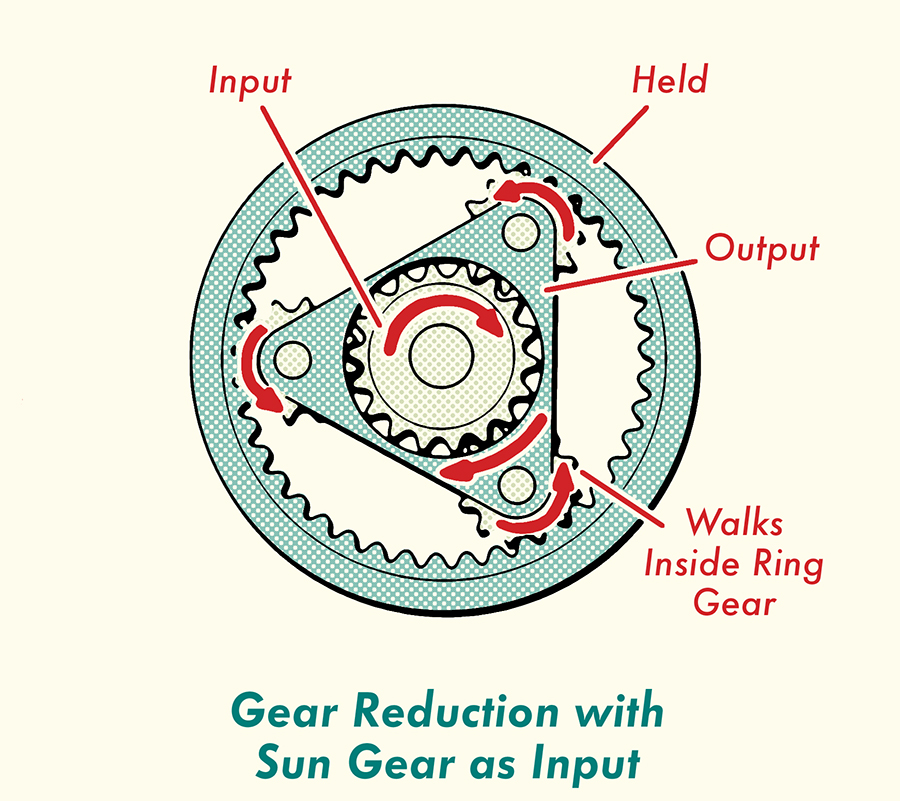
In this scenario, the sun gear is the input gear. The ring gear doesn’t move. With the sun gear moving, and the ring gear held in place, the planetary gears will rotate on their own carrier shafts and walk around the inside of the ring gear, but in the opposite direction as the sun gear. This causes the carrier to rotate in the same direction as the sun gear. The carrier thus becomes the output gear.
This configuration creates a low gear ratio which means the input gear (in this case, the sun gear) spins faster than the output gear (the planet carrier). But the amount of torque the planet carrier creates is much more than the sun gear delivers.
This sort of configuration would be used when the car is just getting started.
Sun Gear: held stationary / Planetary Carrier: output gear / Ring Gear: input gear
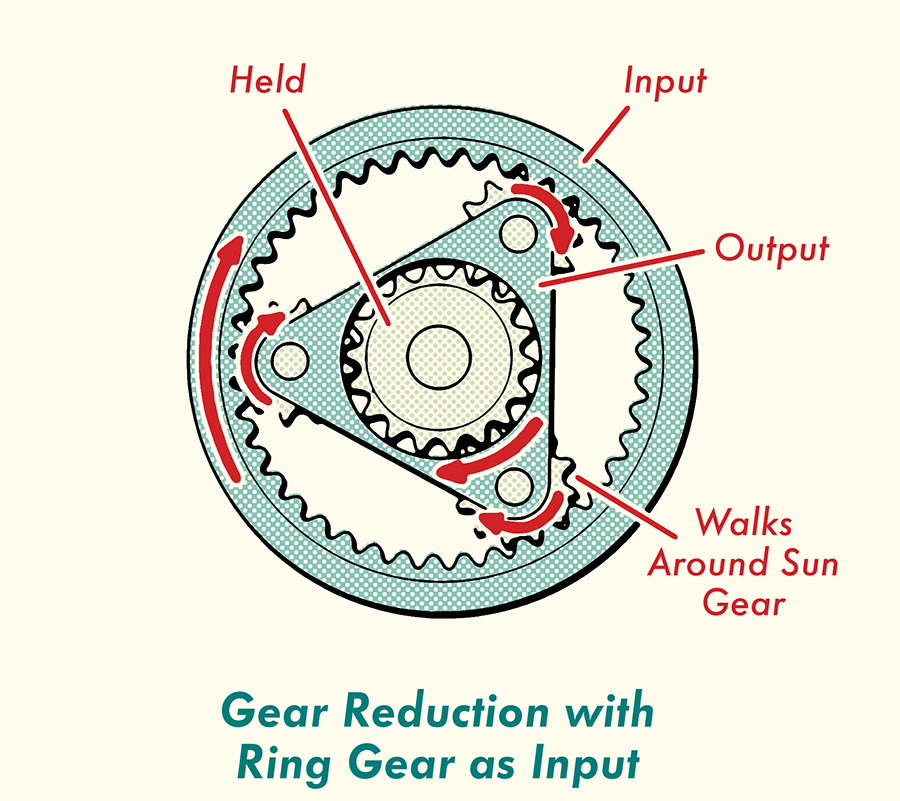
In this scenario, the sun gear is held stationary, but the ring gear becomes the input gear (that is, it’s delivering power to the gear system). Because the sun gear is being held, the spinning planet gears will walk around the sun gear and carry the planet carrier with them.
The planet carrier moves in the same direction as the ring gear and is an output gear.
This configuration creates a bit higher gear ratio than the first configuration. But the input gear (the ring gear) is still spinning faster than the output gear (the planetary carrier). This results in the planetary gear delivering more torque, or power, to the rest of the drivetrain. This configuration would likely be in play as your car speeds up from a dead stop, or when you’re driving up a hill.
Sun Gear: input gear / Planetary Carrier: output gear / Ring Gear: input gear
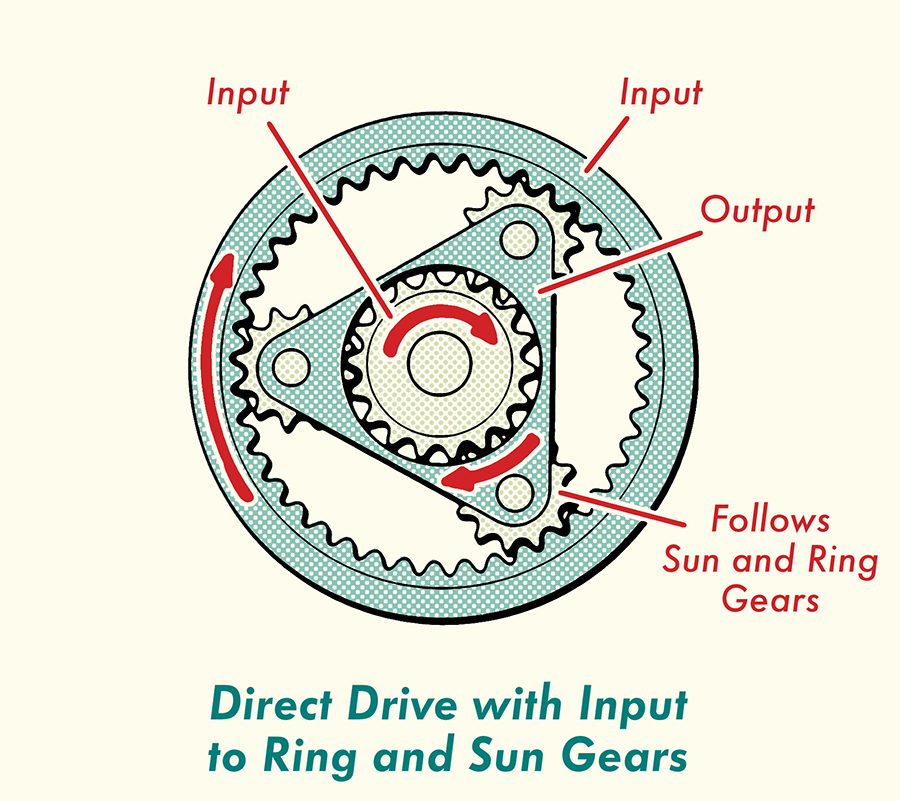
In this scenario, both the sun gear and ring gear act as input gears. That is, both are spinning at the same speed and in the same direction. This causes the planetary gears to not spin on their individual shafts. Why? If the ring gear and the sun gear are the input members, the internal teeth of the ring gear will try to rotate the planetary gears in one direction, while the external teeth of the sun gear will try to drive them in the opposite direction. So they lock into place. The whole unit (sun gear, planetary carrier, ring gear) moves together at the same speed and they transfer the same amount of power. When the input and the output transfer the same amount of torque, it’s called direct drive.
This arrangement would be in play when you’re cruising around 45-50 mph.
Sun Gear: held stationary / Planetary Carrier: input gear / Ring Gear: output gear
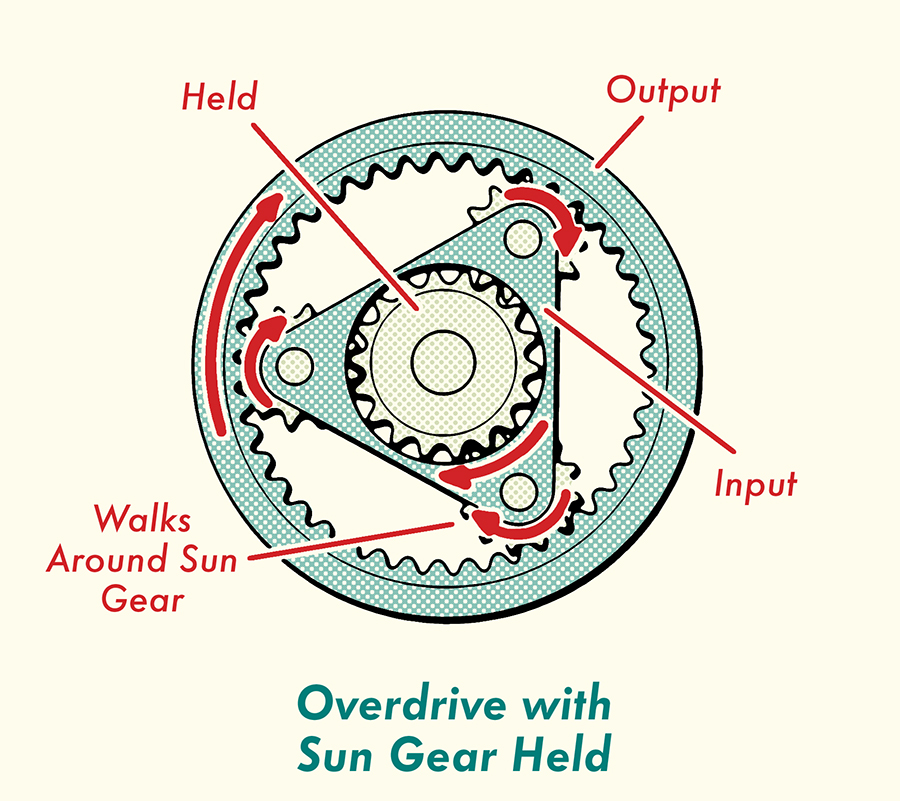
In this scenario, the sun gear is held stationary, and the planetary carrier becomes the input gear that delivers power to the gear system. The ring gear is now the output gear.
As the planet carrier rotates, the planetary gears are forced to walk around the held sun gear, which drives the ring gear faster. One complete rotation of the planet carrier causes the ring gear to rotate more than one complete revolution in the same direction. This is a high gear ratio and provides more output speed but less torque. This arrangement is also known as “overdrive.â€
You’d be in this configuration when you’re driving on the freeway at 60+ mph.
An automatic transmission usually has more than one planetary gear set. They work together to create multiple gear ratios.
Because the gears are in constant mesh in a planetary gear system, gear changes are made without engaging or disengaging gears, like you do on a manual transmission.
But how does an automatic transmission tell which parts of the planetary gear system should act as the input gear, the output gear, or be held stationary, so we can get those varying gear ratios?
With the help of brake bands and clutches inside the transmission.
Brake Bands and Clutches
Brake bands are made of metal lined with organic friction material. The brake bands can tighten to hold the ring or sun gear stationary or loosen to let them spin. Whether a brake band tightens or loosens is controlled by a hydraulic system.
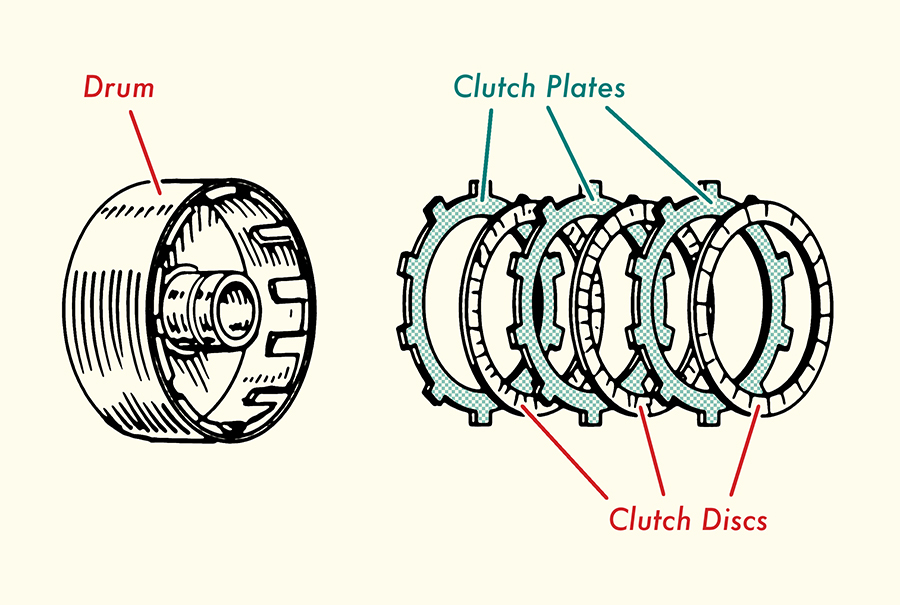
A series of clutches also connect to the different parts of a planetary gear system. Transmission clutches in automatic transmissions are made up of multiple metal and friction discs (which is why they’re sometimes referred to as a “multi disc clutch assemblyâ€). When the discs are pressed together, it causes the clutch to engage. A clutch can cause a planetary gear part to become an input gear or it could cause it to become stationary. It just depends on how it’s connected to the planetary gear. Whether a clutch engages or not is driven by a combination of mechanical, hydraulic, and electrical design. And it all happens automatically.
Now the intricacies of how the various clutches work together to hold and drive different components is pretty complicated. Too complicated to describe it in text. It’s best understood visually. I highly recommend checking out this video that walks you through it:
How an Automatic Transmission Works
As you can see, there are a lot of moving parts inside an automatic transmission. It uses a combination of mechanical, fluid, and electrical engineering to give you a smooth ride from dead stop to highway cruising speed.
So let’s walk through a big picture overview of the power flow in an automatic transmission.
The engine sends power to the torque convertor’s pump.
The pump sends power to the torque converter’s turbine via transmission fluid.
The turbine sends the transmission fluid back to the pump via the stator.
The stator multiples the power of the transmission fluid, allowing the pump to send more power back to the turbine. A vortex power rotation is created inside the torque converter.
The turbine is connected to a central shaft that connects to the transmission. As the turbine spins, the shaft spins, sending power to the first planetary gear set of the transmission.
Depending on which multiple disc clutch or brake band is engaged in the transmission, the power from the torque converter will either cause the sun gear, the planetary carrier, or the ring gear of the planetary gear system to move or stay stationary.
Depending on which parts of the planetary gear system are moving or not determines the gear ratio. Whatever planetary gear arrangement you have (sun gear acting as input, planetary carrier acting as output, ring gear stationary — see above) will determine the amount of power the transmission sends to the rest of the drive train.
That, broadly speaking, is how an automatic transmission works. There are sensors and valves that regulate and modify things, but that’s the basic gist of it.
It’s something that’s easier understood visually. I highly recommend watching the following video. The background we went through will make it much easier to understand:
What did I tell you? The automatic transmission is pretty dang amazing.
Now as you feel the car shift gears as you cruise down the freeway, you’ll have a good idea of what’s going on under the hood.
Tags: Cars

